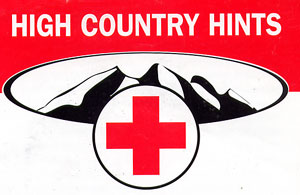
Crested Butte, CO 81224
|
|
|
This information brought to you by the Crested Butte Medical Center
HEALTH TIPS FOR MOUNTAIN VISITORS
Welcome to Crested Butte and the beautiful High Country of Gunnison County. Because of our unique mountain environment and high elevation, we offer you some helpful hints for keeping healthy during your visit.
ALTITUDE & ACUTE MOUNTAIN SICKNESS
Both the towns of Crested Butte (8880ft) and Mt. Crested Butte (9400ft) are located at what is considered to be moderate elevations. With almost all of Gunnison County within the altitude range (some of our mountain peaks go as high as 14,000) you will be exposed to some of the common effects of altitude during your stay. Many people are completely unaffected by the altitude. However, a few people may experience a range of symptoms that we refer to as Acute Mountain Sickness (AMS) or Altitude Illness. These symptoms include shortness of breath, headache, fatigue, a light-headed or dizzy feeling, nausea, decreased appetite, difficulty sleeping, and others. These symptoms will often appear within the first 24 hrs. By following some simple self-care suggestions these symptoms will usually remain mild and resolve within 2-3 days.
-Your first couple of days should be spent "acclimatizing." Activity levels should be moderate.
-Drink several glasses of water (at least 64oz) a day. Dehydration is a common cause of worsening AMS.
-Excessive alchohol should be avoided.
The symptoms of AMS can occasionally progress to its more sever forms. High Altitude Pulmonary Edema (HAPE) and High Altitude Cerebral Edema (HACE) are suspected when shortness of breath, cough and or headaches become severe and persistent. Medical assistance should be contacted immediately.
|
HYPOTHERMIA & FROSTBITE
In summer or winter, Hypothermia can sneak up on the unprepared mountain traveler. Though summer mountain temperatures can oftern be in the 70-80° range, it is not unusual with a passing thunderstorm or the onset of night for temperatures to drop as much as 40°F. Even in the moderate temperatures (50-60°) Hypothermia is a risk, especially if one becomes wet from heavy exertion or rainfall or windchill becomes a factor.
-Proper clothing is the key to prevention. Remember "expect the unexpected." An extra layer of warmth and adequate foul weather gear is only a little added weight to your pack.
In the event that you do become exposed to below freezing temperatures, be aware of the possibility of frostbite of the hands and feet, ears and nose. Do not rub the affected part and, if there is a chance of re-freezing, do not thaw the affected part. Follow up with a physician if you are concerned that you may have susutained a frostbite injury.
|
DEHYDRATION
This is perhaps the most common problem associated with visitors to the high country. Because of our very dry climate, increased respiratory rate, and high activity level of most people visiting the mountains, loss of body fluids can quickly become significant. People are fequently unaware of the onset of dehydration. However, a good "rule of thumb" is to drink AT LEAST 8 glasses of water per day, (a "glass" is 8oz. so a MINIMUM of 64oz.) substantially more if your activity level is high. Many mild symptoms frequently resolve with just an increase in fluid intake. Electrolyte replacement drinks, such as Recharge, Gatorade, etc., are also beneficial. If fluid loss becomes severe, such as due to diarrhea or vomiting, medical consultation is advised.
|
|
|
|
|
|
|
|